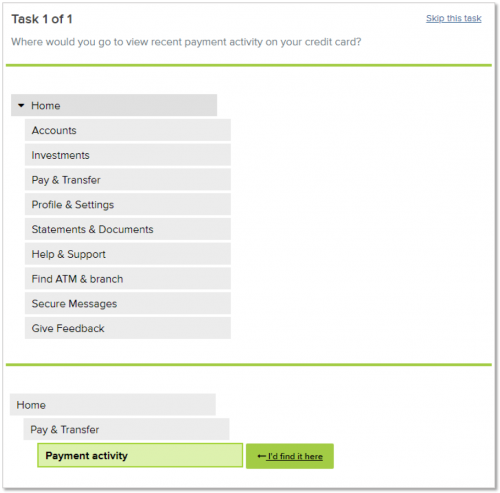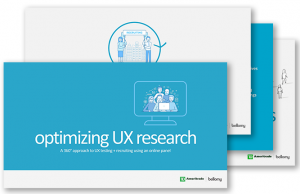Five ways your online community can help you conduct better, faster UX research
Online research communities have been a go-to tool for marketing research for a while now, but we are seeing more and more companies use their existing marketing research panels for user experience research, or even creating panels solely for this purpose.
This trend makes sense given that the majority of customer interactions with companies today occur online. The user experience on a company’s digital platforms has a huge impact on customer perceptions and brand loyalty, but designing and implementing a good user experience isn’t easy. It’s subjective and requires an understanding of various perspectives and behaviors from a multitude of user types.
Arguably the largest barrier to user-research-based design is the difficulty and time associated with identifying, recruiting, and communicating with these users throughout the development cycle.
This is where an online research community can save the day by connecting your business directly to the users of your platforms so you can get faster feedback at every stage.
1. The users you need are right at your fingertips
Recruiting real users of your website or app is often a huge hurdle to conducting user experience research. The beauty of having a community is that all the heavy-lifting of recruiting is done up-front. One of the most important steps to recruiting a strong research community is developing a screening survey and determining the optimal composition for your needs. If there are personas or segments that are key to your research, typing questions can be built into the screener to identify these groups. If you are planning to use your community for user experience research, a series of technographic questions should also be included to identify key user groups by device and platform.
At the end of the day, you have a pool of 100 - 5,000+ users (depending on your needs) who are committed to providing you feedback to improve your platforms. You’ll be able to quickly identify and select eligible users for each study because you already know everything about them — from their demographics to their technology usage to their market segment.
2. Research communities allow for agile usability testing cadences
Moderated user testing should ideally always follow development sprints, but aggressive schedules mean that this key step is often skipped. An online research community helps streamline the process by cutting out the hassle of finding users and makes it easier to get on a regular testing cadence with your customers. Scheduling, participant communication, and tech support are all key components of being able to successfully and efficiently conduct the usability testing sessions. Trained UX moderators can conduct sessions with customers, make sense of the findings, and provide recommendations on the next steps.
The impact of doing regular testing should be measurable and will quickly become apparent. We’ve seen this in action with one of our financial services clients, who utilized their UX research panel to test their app every two weeks, making it one of the top-rated trading apps in the marketplace.
 Access the webinar to see how using an online panel can speed up recruiting and deliver high-quality participants for your iterative UX testing.
Access the webinar to see how using an online panel can speed up recruiting and deliver high-quality participants for your iterative UX testing.
3. Panelists can help you solve design debates almost instantly
Effective platforms should have the ability to field activities like polls, forum discussions, and short surveys in a matter of hours — or even minutes. This gives you an easy way to validate (or invalidate) design decisions as you move through phases of development.
- Not sure which version of an icon will make more sense to users? Take a few minutes to post a poll and you can usually get enough responses to give you the answer in a couple of hours.
- Not sure if the new information architecture of your website is better than the old version? Use parallel tree tests to compare navigation success rates. Have tests fielded to your panel in less than an hour to see if users can find the locations where specific tasks can be completed.
This rapid feedback will enable you to solve internal debates quickly and create user-centered design before any coding is done.

4. Online communities make benchmarking easy
Having an online research community makes it much easier to track your success and capture metrics that will be relevant to your internal teams and stakeholders. You can use your panel to regularly track things like the System Usability Scale (SUS) or overall satisfaction with your website or app. Use metrics relevant to your company’s business goals in order to benchmark new designs against old ones. An e-commerce company might be interested in the time it takes to complete the checkout process. An online brokerage might want to track the time it takes to place a trade. Having a pool of users always available to collect these metrics and ratings makes it easy to document your UX wins and demonstrate the value of your research.
5. Retain and engage the same customers for longitudinal studies
Fresh perspectives are an essential part of UX research, which is why online communities should be regularly refreshed and user participation should be tracked. As a best practice, panelists shouldn’t participate in usability testing more than once every six months. However, there are some instances where you may need to talk to the same users again. Maybe a panelist gave particularly insightful feedback and you would like to get their feedback in another study, or perhaps you have a longitudinal study to test the learnability of a product over time. Having these customers in a community makes it much easier to communicate with them and regularly gather feedback through a series of engagements. On the flip side, panelists are usually more invested and more willing to participate long-term. Can we say win, win?!
Get started with a proprietary, online research community to accelerate your UX research
The consumer feedback you gather through online research communities isn’t limited to market research. Having a group of real customers test your digital platforms can give your team valuable insights into design, usability, and learnability. Maintaining a proprietary research community can accelerate decision-making and ensures your team remains user-centric.
Bellomy has over 40 years of experience in market research. Teams of trained recruiters, moderators, and research specialists are dedicated to building and engaging panels for our clients. Contact one of Bellomy’s user experience research experts to discuss how an online research community can help you achieve your business goals.
- research communities
- ux research




